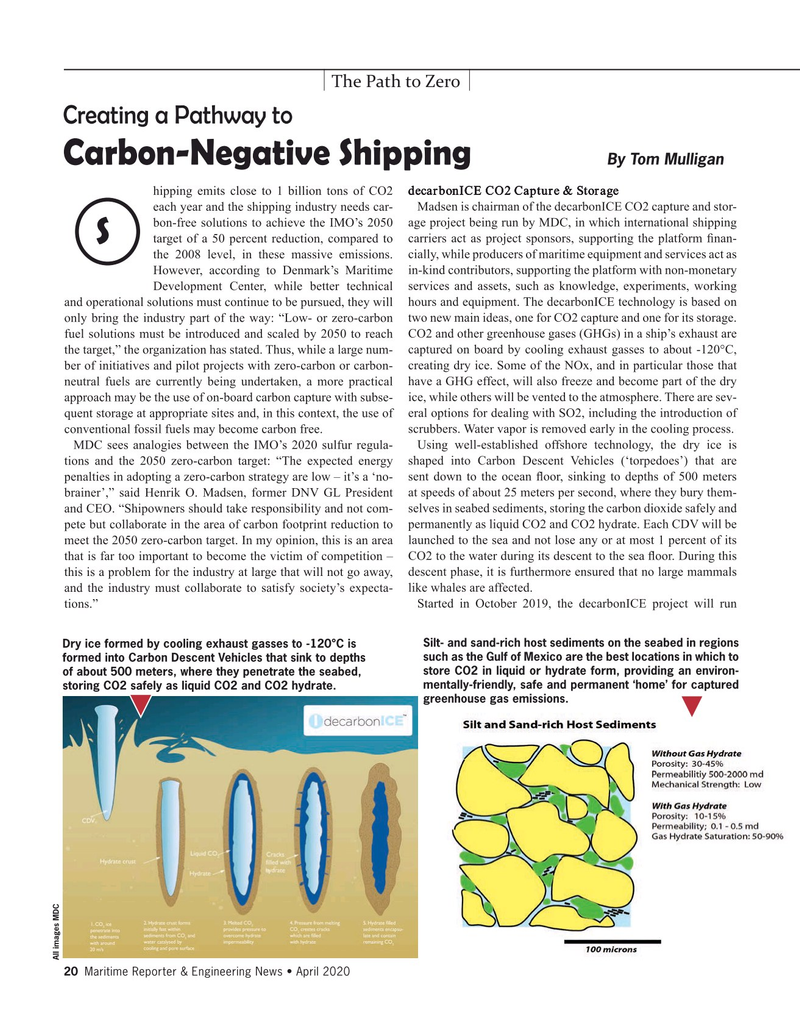
Page 20: of Maritime Reporter Magazine (April 2020)
Offshore Energy Edition
Read this page in Pdf, Flash or Html5 edition of April 2020 Maritime Reporter Magazine
The Path to Zero
Creating a Pathway to
By Tom Mulligan
Carbon-Negative Shipping hipping emits close to 1 billion tons of CO2 decarbonICE CO2 Capture & Storage each year and the shipping industry needs car- Madsen is chairman of the decarbonICE CO2 capture and stor- bon-free solutions to achieve the IMO’s 2050 age project being run by MDC, in which international shipping target of a 50 percent reduction, compared to carriers act as project sponsors, supporting the platform fnan-
S the 2008 level, in these massive emissions. cially, while producers of maritime equipment and services act as
However, according to Denmark’s Maritime in-kind contributors, supporting the platform with non-monetary
Development Center, while better technical services and assets, such as knowledge, experiments, working and operational solutions must continue to be pursued, they will hours and equipment. The decarbonICE technology is based on only bring the industry part of the way: “Low- or zero-carbon two new main ideas, one for CO2 capture and one for its storage. fuel solutions must be introduced and scaled by 2050 to reach CO2 and other greenhouse gases (GHGs) in a ship’s exhaust are the target,” the organization has stated. Thus, while a large num- captured on board by cooling exhaust gasses to about -120°C, ber of initiatives and pilot projects with zero-carbon or carbon- creating dry ice. Some of the NOx, and in particular those that neutral fuels are currently being undertaken, a more practical have a GHG effect, will also freeze and become part of the dry approach may be the use of on-board carbon capture with subse- ice, while others will be vented to the atmosphere. There are sev- quent storage at appropriate sites and, in this context, the use of eral options for dealing with SO2, including the introduction of conventional fossil fuels may become carbon free. scrubbers. Water vapor is removed early in the cooling process.
MDC sees analogies between the IMO’s 2020 sulfur regula- Using well-established offshore technology, the dry ice is tions and the 2050 zero-carbon target: “The expected energy shaped into Carbon Descent Vehicles (‘torpedoes’) that are penalties in adopting a zero-carbon strategy are low – it’s a ‘no- sent down to the ocean foor, sinking to depths of 500 meters brainer’,” said Henrik O. Madsen, former DNV GL President at speeds of about 25 meters per second, where they bury them- and CEO. “Shipowners should take responsibility and not com- selves in seabed sediments, storing the carbon dioxide safely and pete but collaborate in the area of carbon footprint reduction to permanently as liquid CO2 and CO2 hydrate. Each CDV will be meet the 2050 zero-carbon target. In my opinion, this is an area launched to the sea and not lose any or at most 1 percent of its that is far too important to become the victim of competition – CO2 to the water during its descent to the sea foor. During this this is a problem for the industry at large that will not go away, descent phase, it is furthermore ensured that no large mammals and the industry must collaborate to satisfy society’s expecta- like whales are affected.
tions.” Started in October 2019, the decarbonICE project will run
Dry ice formed by cooling exhaust gasses to -120°C is Silt- and sand-rich host sediments on the seabed in regions formed into Carbon Descent Vehicles that sink to depths such as the Gulf of Mexico are the best locations in which to of about 500 meters, where they penetrate the seabed, store CO2 in liquid or hydrate form, providing an environ- storing CO2 safely as liquid CO2 and CO2 hydrate. mentally-friendly, safe and permanent ‘home’ for captured greenhouse gas emissions.
All images MDC 20 Maritime Reporter & Engineering News • April 2020

 19
19

 21
21
